JDBC 概述
基本介绍

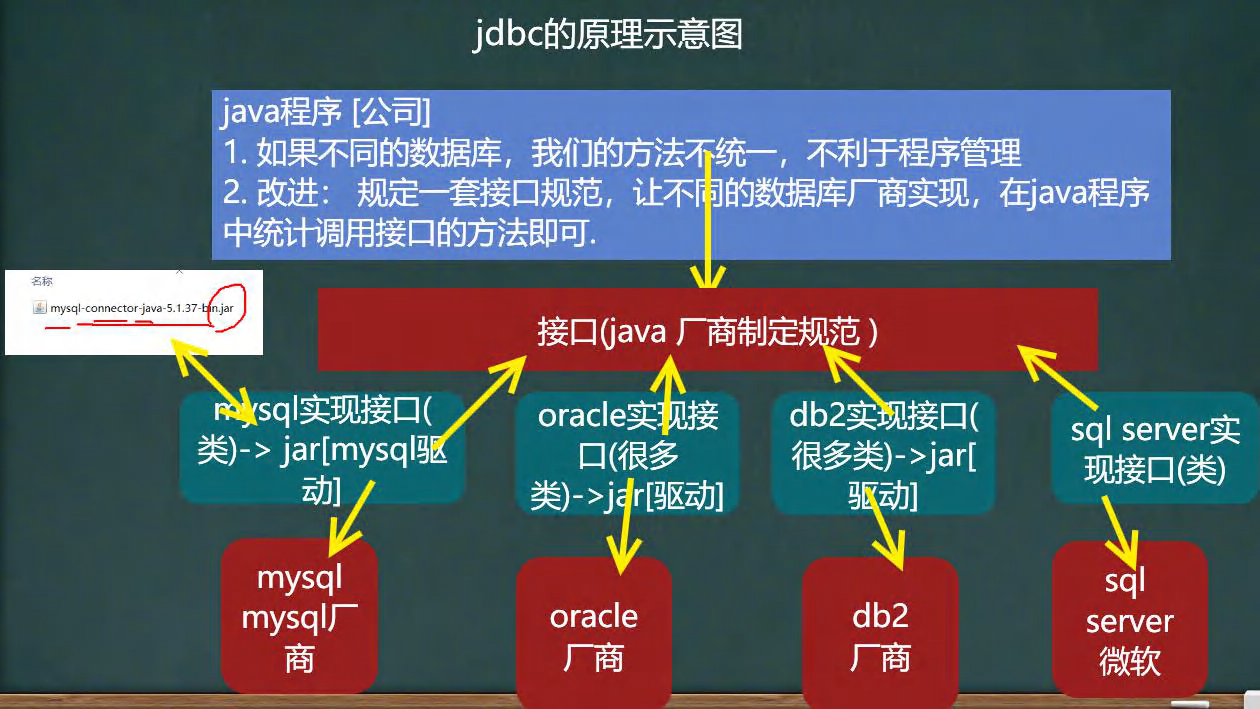
模拟JDBC
public class TestJdbc {
public static void main(String[] args) {
JdbcInterface jdbcInterface = new MysqlJdbcImpl();
//完成对mysql的操作
jdbcInterface.getConnection();
jdbcInterface.crud();
jdbcInterface.close();
}
}
//java 厂商规定的jdbc接口
public interface JdbcInterface {
//连接
public Object getConnection();
//CRUD
public void crud();
//关闭连接
public void close();
}
//mysql数据库实现了jdbc接口(mysql厂商开发)
public class MysqlJdbcImpl implements JdbcInterface {
@Override
public Object getConnection() {
System.out.println("得到mysql的连接");
return null;
}
@Override
public void crud() {
System.out.println("完成mysql增删改查");
}
@Override
public void close() {
System.out.println("关闭mysql的连接");
}
}
JDBC 带来的好处
- JDBC是java提供一套用于数据库操作的接口API,java程序员只需要面向这套接口编程即可.不同的数据库厂商,需要针对这套接口,提供不同实现.
- 如果java直接访问数据库:可行,但不建议,因为这意味着java应用程序没有更好的可移植性.
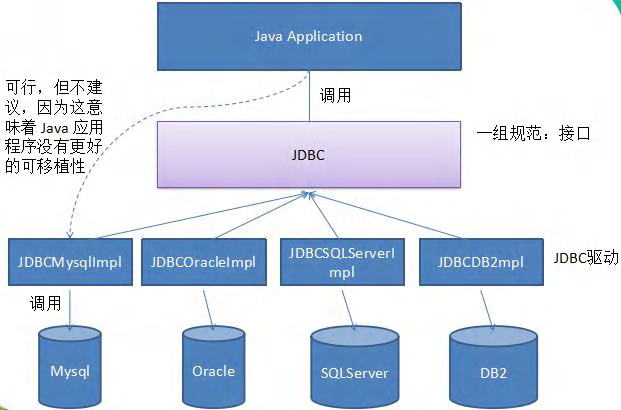
JDBC API
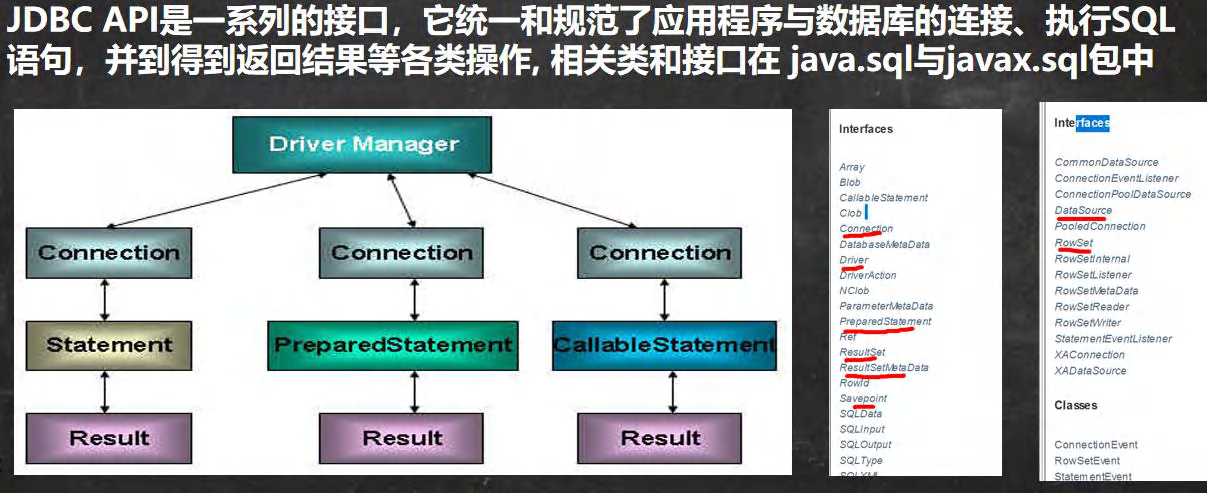
JDBC 快速入门
JDBC程序编写步骤:(先执行前置工作步骤)
- 注册驱动–加载Driver类(该类在驱动包下的com.mysql.jdbc.Driver路径)
- 获取连接–得到Connection
- 执行增删改查–发送SQL给mysql执行
- 释放资源-- 关闭相关连接
前置工作:
- 在项目下创建一个文件夹比如 libs
- 将mysql-connector-java-5.1.37-bin.jar拷贝到该目录下,点击 add to project…加入到项目中
- 该jar包中即为mysql数据库针对java接口做的实现
//jdbc程序,完成简单操作
public class Jdbc01 {
public static void main(String[] args) throws SQLException {
//前置工作: 在项目下创建一个文件夹比如 libs
// 将 mysql.jar 拷贝到该目录下,点击 add to project ..加入到项目中
//1. 注册驱动
Driver driver = new Driver();//com.mysql.jdbc.Driver
//2.得到连接
//(1) jdbc:mysql:// 规定好表示协议,通过jdbc的方式连接mysql
//(2) localhost 主机,可以是ip地址
//(3) 3306 表示mysql监听的端口
//(4) hsp_db02 连接到mysql dbms 的哪个数据库
//(5) mysql的连接本质就是前面学过的socket连接
String url = "jdbc:mysql://localhost:3306/db02";
//将 用户名和密码放入到Properties 对象
Properties properties = new Properties();
properties.setProperty("user", "root");
properties.setProperty("password", "root");
Connection connect = driver.connect(url, properties);
//3.执行sql
String sql = "insert into actor values(null,'刘德华','男','1970-11-11','110')";
sql = "update actor set name='周星驰' where id=1";
sql = "delete from actor where id=1";
//statement 用于执行静态SQL语句并返回其生成的结果的对象
Statement statement = connect.createStatement();
int rows = statement.executeUpdate(sql);//执行sql语句, 如果是 dml语句,返回的就是影响行数
System.out.println(rows > 0 ? "成功" : "失败");
//4.关闭连接资源
statement.close();
connect.close();
}
}
获取数据库连接(5种方式)
- 方式1: 注册驱动(创建Driver对象)–>将user,password存入配置文件(properties)–>使用方法driver.connect(url,properties)得到连接
- 方式2: 注册驱动(通过反射动态加载Driver类–>newInstance()-创建Driver对象)–>将user,password存入配置文件(properties)–>使用方法driver.connect(url,properties)得到连接
- 方式3: 通过反射创建对象–>通过DriverManager静态方法注册驱动–>通过DriverManager静态方法得到连接
- 方式4: 使用反射加载Driver–>类加载执行静态代码块完成注册–>通过DriverManager静态方法得到连接
- 方式5: 增加配置文件–>从配置文件读取到url,user,password,driver参数–>执行方式4步骤
总结:
无论属于5种方式的哪一种,最终都是通过DriverManager静态方法注册驱动,具体表现为两种途径:
- 间接方式:直接创建或通过反射创建或加载Driver类的对象,从而加载Driver类,执行其类中的静态代码块[如下图],调用 DriverManager 静态方法注册驱动
- 直接方式:不创建Driver对象,自动调用驱动包下的类名通过class.forName()去注册
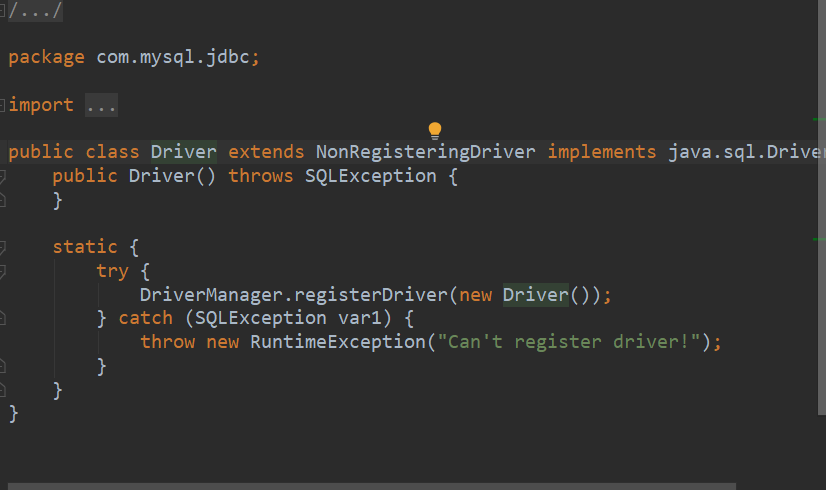
提示:
- mysql驱动5.1.6可以无需Class.forName(“com.mysql.jdbc.Driver”);
- 从jdk1.5以后使用了jdbc4,不再需要显示调用class.forName()注册驱动而是自动调用驱动jar包下META-INF\services\java.sql.Driver文本中的类名称去注册
- 建议还是写上Class.forName(“com.mysql.jdbc.Driver”),更加明确
//java连接mysql的5种方式
public class JdbcConn {
//方式1
@Test
public void connect01() throws SQLException {
Driver driver = new Driver();//创建driver对象
//连接到ip+数据库
String url = "jdbc:mysql://localhost:3306/db02";
//存入mysql用户名密码
Properties properties = new Properties();
properties.setProperty("user", "root");
properties.setProperty("password", "root");
//得到连接
Connection connect = driver.connect(url, properties);
System.out.println(connect);
}
//方式2
@Test
public void connect02() throws ClassNotFoundException, IllegalAccessException, InstantiationException, SQLException {
//通过反射动态加载Driver类,更灵活
Class<?> aClass = Class.forName("com.mysql.jdbc.Driver");
Driver driver = (Driver) aClass.newInstance();
String url = "jdbc:mysql://localhost:3306/db02";
Properties properties = new Properties();
properties.setProperty("user", "root");
properties.setProperty("password", "root");
Connection connect = driver.connect(url, properties);
System.out.println(connect);
}
//方式3 使用DriverManager 替代 driver 进行统一管理
@Test
public void connect03() throws ClassNotFoundException, IllegalAccessException, InstantiationException, SQLException {
Class<?> aClass = Class.forName("com.mysql.jdbc.Driver");
Driver driver = (Driver) aClass.newInstance();
String url = "jdbc:mysql://localhost:3306/db02";
String password = "root";
String user = "root";
//通过DriverManager静态方法注册驱动
DriverManager.registerDriver(driver);
//通过DriverManager静态方法得到连接
Connection connection = DriverManager.getConnection(url, user, password);
System.out.println(connection);
}
//方式4 Driver类加载时自动注册驱动,简化,推荐使用
@Test
public void connect04() throws ClassNotFoundException, SQLException {
//使用反射加载Driver,提示:jdk1.5开始使用jdbc4以后,无需加载,自动调用
Class.forName("com.mysql.jdbc.Driver");
//类加载执行静态代码块完成注册
/*static {
try {
DriverManager.registerDriver(new Driver());
} catch (SQLException var1) {
throw new RuntimeException("Can't register driver!");
}
}*/
String url = "jdbc:mysql://localhost:3306/db02";
String password = "root";
String user = "root";
Connection connection = DriverManager.getConnection(url, user, password);
System.out.println("connection = " + connection);
}
//方式5 增加配置文件,更加灵活
@Test
public void connect05() throws IOException, ClassNotFoundException, SQLException {
//通过Properties对象获取配置文件信息
Properties properties = new Properties();
properties.load(new FileReader("src\\mysql.properties"));
String url = properties.getProperty("url");
String user = properties.getProperty("user");
String password = properties.getProperty("password");
String driver = properties.getProperty("driver");
Class<?> aClass = Class.forName(driver);//建议写上
Connection connection = DriverManager.getConnection(url, user, password);
System.out.println("connection = " + connection);
}
}
ResultSet结果集
基本介绍

debug查看resultSet内部结构
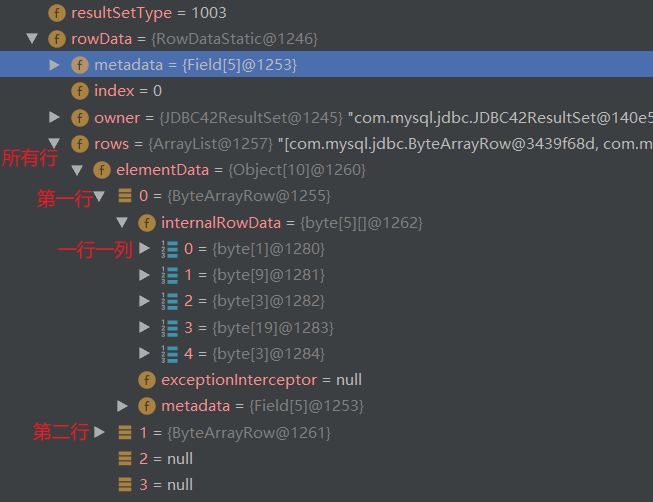
由图看出:
- resultSet底层维护了ArrayList集合存入了多行记录
- 每行记录由byte类型二维数组维护
- 该行的每列(标量)存放在byte[]中
代码实现:
//演示select语句返回结果集,并取出结果
public class ResultSet_ {
public static void main(String[] args) throws IOException, ClassNotFoundException, SQLException {
//通过Properties对象获取配置文件的信息
Properties properties = new Properties();
properties.load(new FileReader("chapter25\\src\\mysql.properties"));
String url = properties.getProperty("url");
String user = properties.getProperty("user");
String password = properties.getProperty("password");
String driver = properties.getProperty("driver");
//1. 注册驱动
Class.forName(driver);
//2. 得到连接
Connection connection = DriverManager.getConnection(url, user, password);
//3. 得到Statement
Statement statement = connection.createStatement();
//4. 组织SqL
String sql = "select id,name,sex,borndate,phone from actor";
//debug得到resultSet类型:com.mysql.jdbc.JDBC42ResultSet@6e0e048a
//该对象里有rowData-->rows-->elementDate存放每行记录里的数据
//执行给定的SQL语句,该语句返回单个 ResultSet对象
ResultSet resultSet = statement.executeQuery(sql);
while (resultSet.next()) {// 让光标向后移动,如果没有更多行,则返回false
int id = resultSet.getInt(1);//获取该行的第1列
// int id = resultSet.getInt("id");通过列名来获取值, 推荐
String name = resultSet.getString(2);
String sex = resultSet.getString(3);
Date date = resultSet.getDate(4);
System.out.println(id+"\t"+name+"\t"+sex+"\t"+date);
}
//关闭连接
resultSet.close();
statement.close();
connection.close();
}
}
Statement
基本介绍
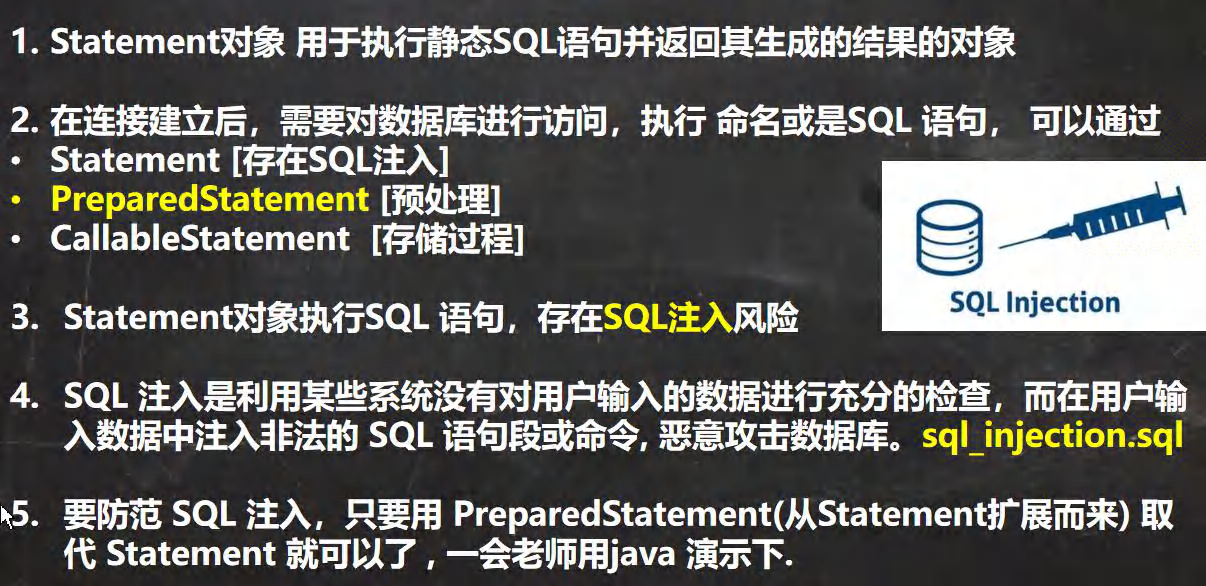
mysql中演示sql注入
create table admin
(`name` varchar(32)not null unique,
`pwd` varchar(32) not null default '')character set utf8;
insert into admin values('tom','123');
-- 查找某个管理是否存在
select * from admin where `name`='tom' AND `pwd`='123';
-- sql注入:tom as 1' or , 123 as or '1'='1
select * from admin where `name`='1' or' AND `pwd`='or '1'='1';
说明:
当查询时可在输入过滤条件的参数时使用万能用户名(1’ or)和密码( or ‘1’='1)即可
jdbc中演示SQL注入
//演示statement的注入问题
public class Statement_ {
public static void main(String[] args) throws IOException, ClassNotFoundException, SQLException {
Scanner sc = new Scanner(System.in);
System.out.println("请输入用户名:");//1' or
String name = sc.nextLine();//next(): 当接收到 空格或者 '就是表示结束,只能用nextLine
System.out.println("请输入密码:");// or '1' = '1
String pwd = sc.nextLine();
Properties properties = new Properties();
properties.load(new FileReader("chapter25\\src\\mysql.properties"));
String user = properties.getProperty("user");
String password = properties.getProperty("password");
String driver = properties.getProperty("driver");
String url = properties.getProperty("url");
Class.forName(driver);
Connection connection = DriverManager.getConnection(url, user, password);
Statement statement = connection.createStatement();
String sql = "select name,pwd from admin where name='"+name+"' and pwd='"+pwd+"'";
ResultSet resultSet = statement.executeQuery(sql);
if (resultSet.next()) { //如果查询到一条记录,则说明该管理存在
System.out.println("恭喜,登录成功");
} else {
System.out.println("抱歉,登录失败");
}
resultSet.close();
statement.close();
connection.close();
}
}
PreparedStatement
基本介绍

预处理好处
- 不再使用+拼接sql语句,减少语法错误
- 有效的解决了sql注入问题
- 大大减少了编译次数,效率较高
查询应用案例:
//演示PreparedStatement使用:有效防止statement注入
public class PreparedStatement_ {
public static void main(String[] args) throws IOException, ClassNotFoundException, SQLException {
Scanner sc = new Scanner(System.in);
System.out.println("请输入用户名:");//1' or
String name = sc.nextLine();//next(): 当接收到 空格或者 '就是表示结束,只能用nextLine
System.out.println("请输入密码:");// or '1' = '1
String pwd = sc.nextLine();
Properties properties = new Properties();
properties.load(new FileReader("chapter25\\src\\mysql.properties"));
String user = properties.getProperty("user");
String password = properties.getProperty("password");
String driver = properties.getProperty("driver");
String url = properties.getProperty("url");
Class.forName(driver);
Connection connection = DriverManager.getConnection(url, user, password);
//先组织字段值为?的sql语句-->构造PreparedStatement对象时使用
String sql = "select name,pwd from admin where name=? and pwd=?";
PreparedStatement preparedStatement = connection.prepareStatement(sql);
//调用方法给?赋值
preparedStatement.setString(1, name);
preparedStatement.setString(2, pwd);
//执行select语句时再不可填入sql作为参数
ResultSet resultSet = preparedStatement.executeQuery();
if (resultSet.next()) { //如果查询到一条记录,则说明该管理存在
System.out.println("恭喜,登录成功");
} else {
System.out.println("抱歉,登录失败");
}
resultSet.close();
preparedStatement.close();
connection.close();
}
}
DML案例:
//演示预处理方式使用dml语句
@SuppressWarnings({"all"})
public class PreparedStatementDML_ {
public static void main(String[] args) throws IOException, ClassNotFoundException, SQLException {
Scanner sc = new Scanner(System.in);
System.out.println("请输入用户名:");//1' or
String name = sc.nextLine();//next(): 当接收到 空格或者 '就是表示结束,只能用nextLine
System.out.println("请输入密码:");// or '1' = '1
String pwd = sc.nextLine();
Properties properties = new Properties();
properties.load(new FileReader("chapter25\\src\\mysql.properties"));
String user = properties.getProperty("user");
String password = properties.getProperty("password");
String driver = properties.getProperty("driver");
String url = properties.getProperty("url");
Class.forName(driver);
Connection connection = DriverManager.getConnection(url, user, password);
//先组织字段值为?的sql语句-->构造PreparedStatement对象时使用
String sql = "select name,pwd from admin where name=? and pwd=?";
sql = "insert into admin values(?,?)";
sql = "update admin set pwd=? where name=?";//注意两个字段赋值的顺序变化
sql = "delete from admin where name =?";
PreparedStatement preparedStatement = connection.prepareStatement(sql);
//调用方法给?赋值
preparedStatement.setString(1, name);
preparedStatement.setString(2, pwd);
//执行DML语句
int update = preparedStatement.executeUpdate();
System.out.println(update>0?"执行成功":"受影响的行数为0");
preparedStatement.close();
connection.close();
}
}
JDBC相关API小结
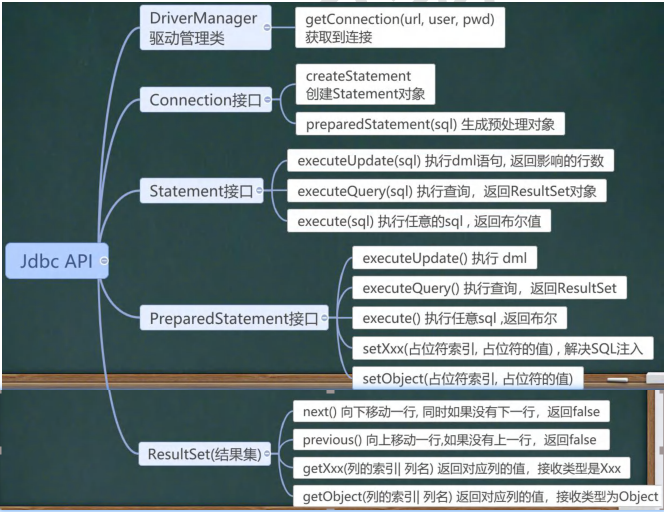
总结:以上接口都是在导入的mysql-connector-java-5.1.37-bin.jar中提供实现,即mysql提供.
封装 JDBCUtils
在jdbc操作中,获得连接和释放资源是经常用到的,可以将其封装到JDBC连接的工具类:JDBCUtils
作用:完成 mysql的连接和关闭资源
代码实现:
//工具类,完成 mysql的连接和关闭资源(因为连接和关闭只执行一次,使用静态成员)
public class JDBCUtils {
private static String url;
private static String user;
private static String pwd;
private static String driver;
//初始化读取属性值
static {
Properties properties = new Properties();
try {
properties.load(new FileReader("src\\mysql.properties"));
url = properties.getProperty("url");
user = properties.getProperty("user");
pwd = properties.getProperty("password");
driver = properties.getProperty("driver");
} catch (IOException e) {
//在实际开发中,我们可以这样处理
//1. 将编译异常转成 运行异常
//2. 调用者,可以选择捕获该异常,也可以选择默认处理该异常,比较方便.
throw new RuntimeException(e);
}
}
//得到连接
public static Connection getConnect() {
try {
return DriverManager.getConnection(url, user, pwd);
} catch (Exception e) {
throw new RuntimeException(e);
}
}
//关闭相关资源(如果没有该对象传入null)
public static void close(ResultSet resultSet, Statement statement, Connection connection) {
try {
if (resultSet != null) {
resultSet.close();
}
if (statement != null) {
statement.close();
}
if (connection != null) {
connection.close();
}
} catch (SQLException e) {
throw new RuntimeException(e);
}
}
}
- 使用JDBCUtils工具类,完成CRUD
//演示使用JDBCUtils工具类,完成dml 和 select
public class JDBCUtils_Use {
@Test
public void testSelect() throws SQLException {//使用trycatch捕捉的话注意待关闭的资源的引用(变量)的作用域
//使用工具类静态方法得到连接
Connection connect = JDBCUtils.getConnect();
System.out.println(connect.getClass());//(Collection在mysql中的实现类)class com.mysql.jdbc.JDBC4Connection
//sql
String sql = "select id,name,sex,borndate,phone from actor where id=?";
PreparedStatement preparedStatement = connect.prepareStatement(sql);
//?赋值
preparedStatement.setInt(1,2);
//查询(1条),获得结果集
ResultSet resultSet = preparedStatement.executeQuery();
System.out.println(resultSet.getClass());
//指针下移
resultSet.next();
//处理结果集
int id = resultSet.getInt("id");
String name = resultSet.getString("name");
String sex = resultSet.getString("sex");
Date borndate = resultSet.getDate("borndate");
String phone = resultSet.getString("phone");
System.out.println(id + "\t" + name + "\t" + sex + "\t" + borndate + "\t" + phone);
//关闭资源
JDBCUtils.close(resultSet, preparedStatement, connect);
}
@Test
public void testDML() {
Connection connection = null;
PreparedStatement preparedStatement = null;
try {
connection = JDBCUtils.getConnect();
String sql = "update actor set name='周星驰' where id=?";
preparedStatement = connection.prepareStatement(sql);
preparedStatement.setInt(1, 2);
preparedStatement.executeUpdate();
} catch (Exception e) {
e.printStackTrace();
} finally {
JDBCUtils.close(null,preparedStatement,connection);
}
}
}
事务
基本介绍

应用实例
模拟经典的转账业务

- 不使用事务可能出现的问题:默认情况下,connection是默认自动提交,导致执行1条sql语句后如果出现异常,由于try catch的特性,后面的sql语句没有被执行,导致转账出错
- 使用事务保持一致性,全部执行或全部回退,不会发生上述情况
代码实现:
//jdbc 中使用事务
public class Transaction_ {
@Test
public void noTransaction() {
Connection connection = null;
PreparedStatement preparedStatement = null;
try {
connection = JDBCUtils.getConnect();
String sql = "update account set balance=balance-100 where id=1";
preparedStatement = connection.prepareStatement(sql);
preparedStatement.executeUpdate();//该方法无参默认执行由连接获得preparedstatement的方法中的sql
int i=1/0;//转账失败,化腾血亏100块
String sql2 = "update account set balance=balance+100 where id=2";
preparedStatement.executeUpdate(sql2);//该方法优先执行自己的sql2
} catch (Exception e) {
e.printStackTrace();
} finally {
JDBCUtils.close(null,preparedStatement,connection);
}
}
@Test
public void transaction() {
Connection connection = null;
PreparedStatement preparedStatement = null;
try {
//在默认情况下,connection是默认自动提交
connection = JDBCUtils.getConnect();
//开启事务
connection.setAutoCommit(false);
String sql = "update account set balance=balance-100 where id=1";
preparedStatement = connection.prepareStatement(sql);
preparedStatement.executeUpdate();//该方法无参默认执行由连接获得preparedstatement的方法中的sql
int i=1/0;//转账失败,终止交易,化腾不亏即血赚
String sql2 = "update account set balance=balance+100 where id=2";
preparedStatement.executeUpdate(sql2);//该方法优先执行自己的sql2
//提交事务
connection.commit();
} catch (Exception e) {
//这里我们可以进行回滚,即撤销执行的SQL
//默认回滚到事务开始的状态.
System.out.println("执行发生了异常,撤销执行的sql");
try {
connection.rollback();
} catch (SQLException e1) {
e1.printStackTrace();
}
e.printStackTrace();
} finally {
JDBCUtils.close(null,preparedStatement,connection);
}
}
}
批处理
基本介绍

应用实例
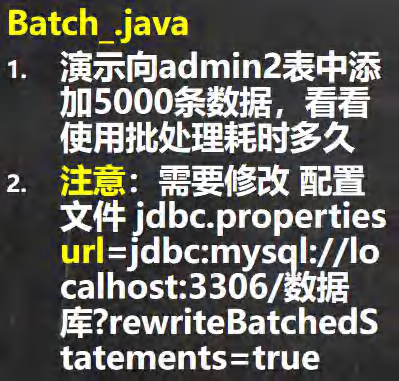
准备工作:创建mysql中表格
create table admin2(
id int primary key auto_increment,
username varchar(32) not null,
`password` varchar(32) not null);
jdbc代码实现:
//jdbc 的批处理
//总结:执行多条SQL语句:
//方式1:每次执行(executeUpdate)完sql,
//-->只需更新sql语句内容(sql赋新值或者setString等方法改sql参数)
//-->再执行(executeUpdate)改变的sql
//方式2:向集合中加入(addBatch(Str/no paramters))改后的sql,批量执行
public class Batch_ {
@SuppressWarnings({"all"})
@Test
public void noBatch() throws SQLException {
Connection connect = JDBCUtils.getConnect();
String sql = "insert into admin2 values(null ,?,?)";
PreparedStatement preparedStatement = connect.prepareStatement(sql);
long start = System.currentTimeMillis();
for (int i = 0; i < 5000; i++) {
preparedStatement.setString(1, "jack[" + i + "]");
preparedStatement.setString(2, "123");
preparedStatement.executeUpdate();
}
long end = System.currentTimeMillis();
System.out.println("不使用批处理耗时:" + (end - start));//6358ms
JDBCUtils.close(null, preparedStatement, connect);
}
@Test//别忘了改配置文件的url参数?rewriteBatchedStatements=true
public void batch() throws SQLException {
Connection connect = JDBCUtils.getConnect();
String sql = "insert into admin2 values(null ,?,?)";
PreparedStatement preparedStatement = connect.prepareStatement(sql);
long start = System.currentTimeMillis();
for (int i = 0; i < 5000; i++) {
preparedStatement.setString(1, "jack[" + i + "]");
preparedStatement.setString(2, "123");
//将sql 语句加入到批处理包中 -> 看源码
/*
//1. //第一就创建 ArrayList - elementData => Object[]
//2. elementData => Object[] 就会存放我们预处理的sql语句
//3. 当elementData满后,就按照1.5扩容
//4. 当添加到指定的值后,就executeBatch
//5. 批量处理会减少我们发送sql语句的网络开销,而且减少编译次数,因此效率提高
public void addBatch() throws SQLException {
synchronized(this.checkClosed().getConnectionMutex()) {
if (this.batchedArgs == null) {
this.batchedArgs = new ArrayList();
}
for(int i = 0; i < this.parameterValues.length; ++i) {
this.checkAllParametersSet(this.parameterValues[i], this.parameterStreams[i], i);
}
this.batchedArgs.add(new PreparedStatement.BatchParams(this.parameterValues, this.parameterStreams, this.isStream, this.streamLengths, this.isNull));
}
}
*/
preparedStatement.addBatch();//preparedStatement中的SQL语句放入 集合
if ((i + 1) % 1000 == 0) {
preparedStatement.executeBatch();
preparedStatement.clearBatch();
}
}
long end = System.currentTimeMillis();
System.out.println("使用批处理耗时:" + (end - start));//142ms
JDBCUtils.close(null, preparedStatement, connect);
}
}
数据库连接池
问题引出
5k次连接数据库问题:
- 编写程序完成连接MySQL5000次的操作
- 看看有什么问题,耗时又是多久.==>数据库连接池
//测试传统方式连接的速度
public class ConQuestion {
@Test
public void testCon() {
System.out.println("开始连接...");
long start = System.currentTimeMillis();
for (int i = 0; i < 5000; i++) {
Connection connect = JDBCUtils.getConnect();//如果不关闭连接:Too many connections
JDBCUtils.close(null,null,connect);
}
long end = System.currentTimeMillis();
System.out.println("传统方式连5000次耗时:"+(end-start));//13197ms
}
}
问题分析
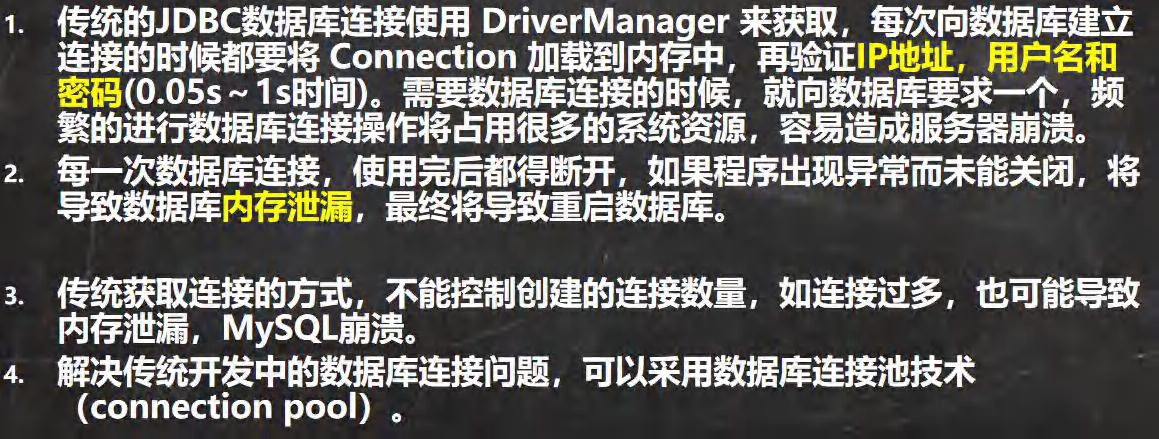
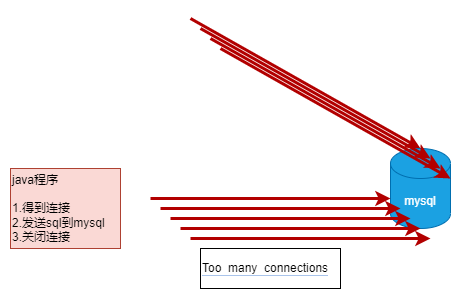
数据库连接池种类
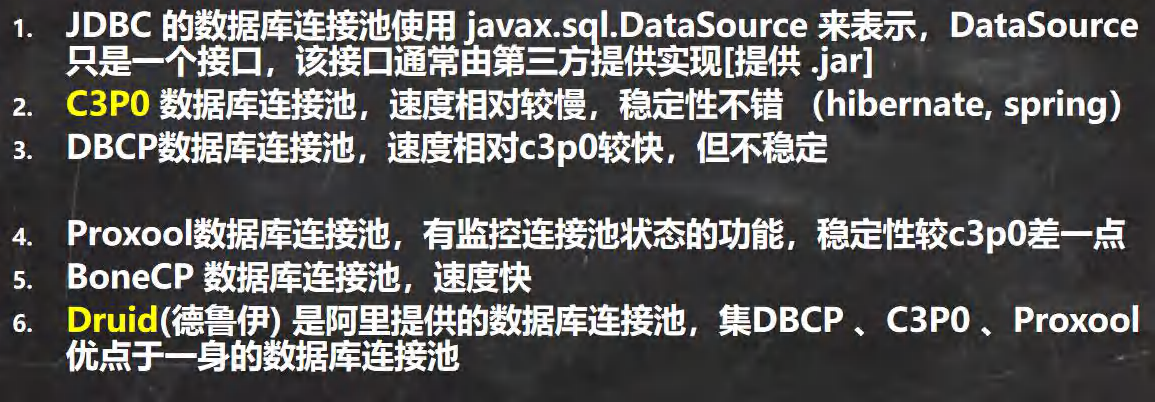
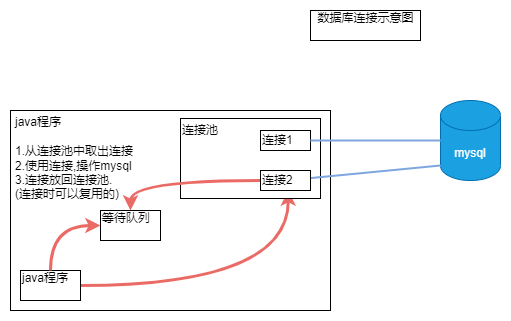
说明:使用了第三方数据库连接池后,连接池,连接等接口以及接口对应的方法都改为由第三方提供实现(jar驱动包中)
C3P0应用实例
前置工作:
- 将c3p0-0.9.1.2.jar拷贝到项目下指定的目录(libs)下,点击 add to project…加入到项目中,包中提供数据库连接池接口的实现–>数据库连接池接口的实现类型变成com.mchange.v2.c3p0.ComboPooledDataSource–>Connection接口的实现类型变成com.mchange.v2.c3p0.impl.NewProxyConnection
- 将c3p0-config.xml拷贝到项目目录(src)下,该文件指定了连接数据库和连接池的相关参数(url,user,password,driver驱动路径)
//演示使用c3p0
public class C3P0_ {
//方式1: 相关参数,在程序中指定user, url , password等
@Test
public void testC3P0_01() throws Exception {
//1. 创建一个数据源对象
ComboPooledDataSource comboPooledDataSource = new ComboPooledDataSource();//com.mchange.v2.c3p0.ComboPooledDataSource
//2. 通过配置文件mysql.properties 获取相关连接的信息
Properties properties = new Properties();
properties.load(new FileReader("src\\mysql.properties"));
String url = properties.getProperty("url");
String user = properties.getProperty("user");
String password = properties.getProperty("password");
String driver = properties.getProperty("driver");
//给数据源 comboPooledDataSource 设置相关的参数
//注意:连接管理是由 comboPooledDataSource 来管理
comboPooledDataSource.setDriverClass(driver);
comboPooledDataSource.setJdbcUrl(url);
comboPooledDataSource.setUser(user);
comboPooledDataSource.setPassword(password);
//设置初始化连接数
comboPooledDataSource.setInitialPoolSize(10);
//最大连接数
comboPooledDataSource.setMaxPoolSize(50);
long start = System.currentTimeMillis();
for (int i = 0; i < 5000; i++) {
Connection connection = comboPooledDataSource.getConnection();
connection.close();
}
long end = System.currentTimeMillis();
System.out.println("c3p0连接5000次耗时:"+(end-start));//1119
}
//第二种方式 使用配置文件模板来完成
//1. 将c3p0 提供的 c3p0.config.xml 拷贝到 src目录下
//2. 该文件指定了连接数据库和连接池的相关参数
@Test
public void testc3p0_02() throws SQLException {
//提示:该方式的构造器参数不能为空,且与配置文件的named-config name保持一致
ComboPooledDataSource comboPooledDataSource = new ComboPooledDataSource("hello");
long start = System.currentTimeMillis();
for (int i = 0; i < 5000; i++) {
Connection connection = comboPooledDataSource.getConnection();
connection.close();
}
long end = System.currentTimeMillis();
System.out.println("c3p0连接5000次耗时:"+(end-start));//1018
}
}
Druid(德鲁伊)应用实例
前置工作:
- 将druid-1.1.10.jar拷贝到项目下指定的目录(libs)下,点击 add to project…加入到项目中,包中提供数据库连接池接口的实现–>数据库连接池接口的实现类型变成com.alibaba.druid.pool.DruidDataSource–>Connection接口的实现类型变成com.alibaba.druid.pool.DruidPooledConnection
- 将druid.properties拷贝到项目目录(src)下,该文件指定了连接数据库和连接池的相关参数(url,user,password,driver驱动路径)
使用:
//Druid数据库连接管理的使用
public class Druid_ {
@Test
public void testDruid() throws Exception {
Properties properties = new Properties();
properties.load(new FileReader("src\\druid.properties"));
DataSource dataSource = DruidDataSourceFactory.createDataSource(properties);
long start = System.currentTimeMillis();
for (int i = 0; i < 5000; i++) {
Connection connection = dataSource.getConnection();
connection.close();
}
long end = System.currentTimeMillis();
System.out.println("druid连接5000次耗时:"+(end-start));//741
}
}
Druid工具类
说明:将 JDBCUtils 工具类改成Druid (德鲁伊)实现
功能:创建一个数据源对象–>通过配置文件druid.properties 获取相关连接的信息–>得到连接Connection(引用)–>关闭连接(将连接引用的对象放回连接池)
//基于druid数据库连接池的工具类
public class JDBCUtilsByDruid {
private static DataSource dataSource;
static {
Properties properties = new Properties();
try {
properties.load(new FileReader("src\\druid.properties"));
dataSource = DruidDataSourceFactory.createDataSource(properties);
} catch (Exception e) {
e.printStackTrace();
}
}
public static Connection getConnection() {
Connection connection=null;
try {
connection=dataSource.getConnection();
} catch (SQLException e) {
e.printStackTrace();
}
return connection;
}
public static void close(ResultSet resultSet, Statement statement, Connection connection) {
try {
if (resultSet != null) {
resultSet.close();
}
if (statement != null) {
statement.close();
}
if (connection != null) {
//Connection是接口,因第三方不同,Collection实现类不同
//这里关闭机制由原来的mysql里Collection实现类提供
//改为由Druid里的实现类提供关闭机制
//两者区别:后者把引用断掉,collection对象放回连接池
//前者:直接断开JDBC数据库连接
connection.close();
}
} catch (SQLException e) {
throw new RuntimeException(e);
}
}
}
使用Druid工具类
public class JDBCUtilsByDruid_USE {
@Test
public void testSelect() throws SQLException {//使用trycatch捕捉的话注意待关闭的资源的引用(变量)的作用域
//使用工具类静态方法得到连接
Connection connect = JDBCUtilsByDruid.getConnection();
System.out.println(connect.getClass());//(Collection在Druid中的实现类)class com.alibaba.druid.pool.DruidPooledConnection
//sql
String sql = "select id,name,sex,borndate,phone from actor where id=?";
PreparedStatement preparedStatement = connect.prepareStatement(sql);
//?赋值
preparedStatement.setInt(1,2);
//查询(1条),获得结果集
ResultSet resultSet = preparedStatement.executeQuery();
//如果在操作结果集之前就关闭连接即关闭结果集 ,会异常
//-->Operation not allowed after ResultSet closed
//-->因此在关闭之前就要将读取结果封装到集合中
//指针下移
resultSet.next();
//处理结果集
int id = resultSet.getInt("id");
String name = resultSet.getString("name");
String sex = resultSet.getString("sex");
Date borndate = resultSet.getDate("borndate");
String phone = resultSet.getString("phone");
System.out.println(id + "\t" + name + "\t" + sex + "\t" + borndate + "\t" + phone);
//关闭资源
JDBCUtilsByDruid.close(resultSet, preparedStatement, connect);
}
}
Apache-DBUtils
分析问题
- 关闭connection后,resultSet结果集无法使用
- resultSet不利于数据的管理
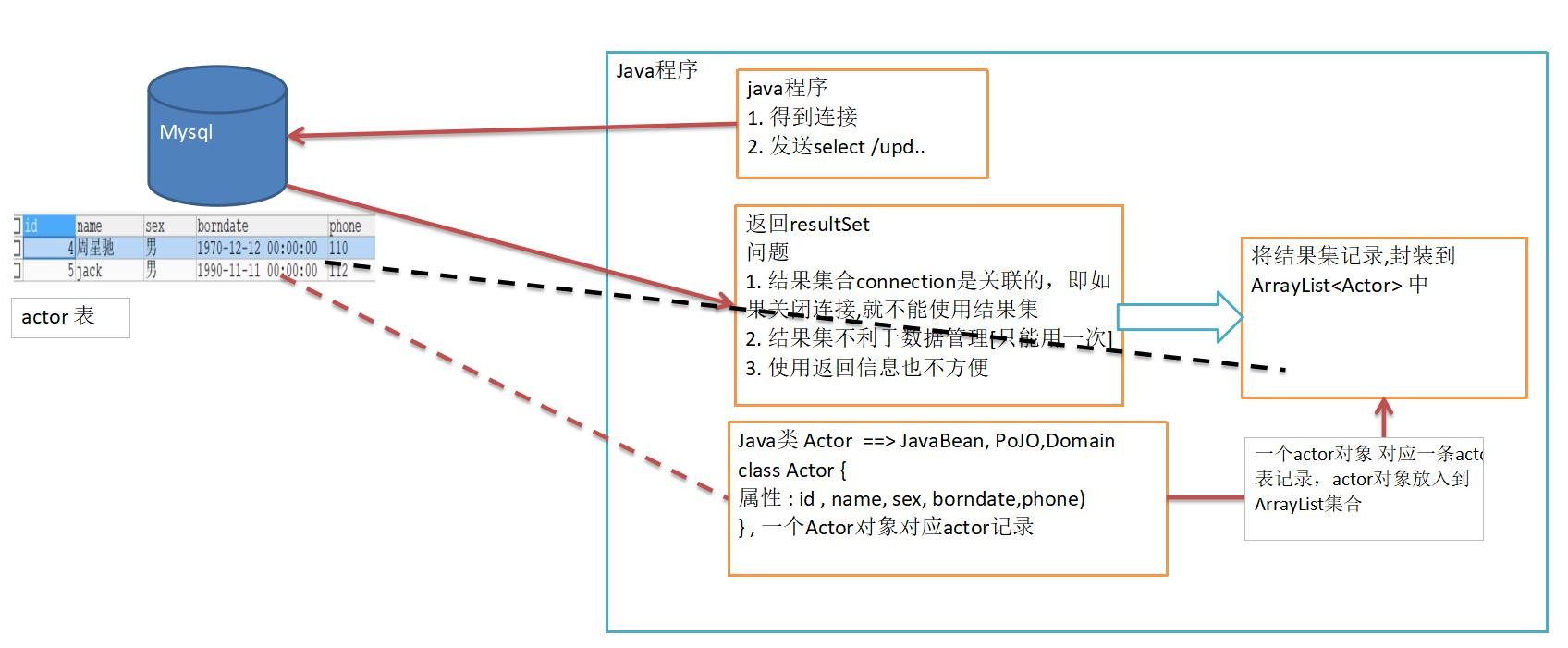
自行尝试解决
手动封装记录:创建集合–>将循环读取resultSet中的记录并保存在事先创建的集合中
@Test
public void testSelectToArrayList() throws SQLException {
ArrayList<Actor> list = new ArrayList<>();
Connection connection = JDBCUtilsByDruid.getConnection();
String sql = "select * from actor where id>?";
PreparedStatement preparedStatement = connection.prepareStatement(sql);
preparedStatement.setInt(1,0);
ResultSet resultSet = preparedStatement.executeQuery();
while (resultSet.next()) {
int id = resultSet.getInt("id");
String name = resultSet.getString("name");
String sex = resultSet.getString("sex");
Date borndate = resultSet.getDate("borndate");
String phone = resultSet.getString("phone");
list.add(new Actor(id, name, sex, borndate, phone));
}
JDBCUtilsByDruid.close(resultSet, preparedStatement, connection);
System.out.println(list);
}
工具介绍
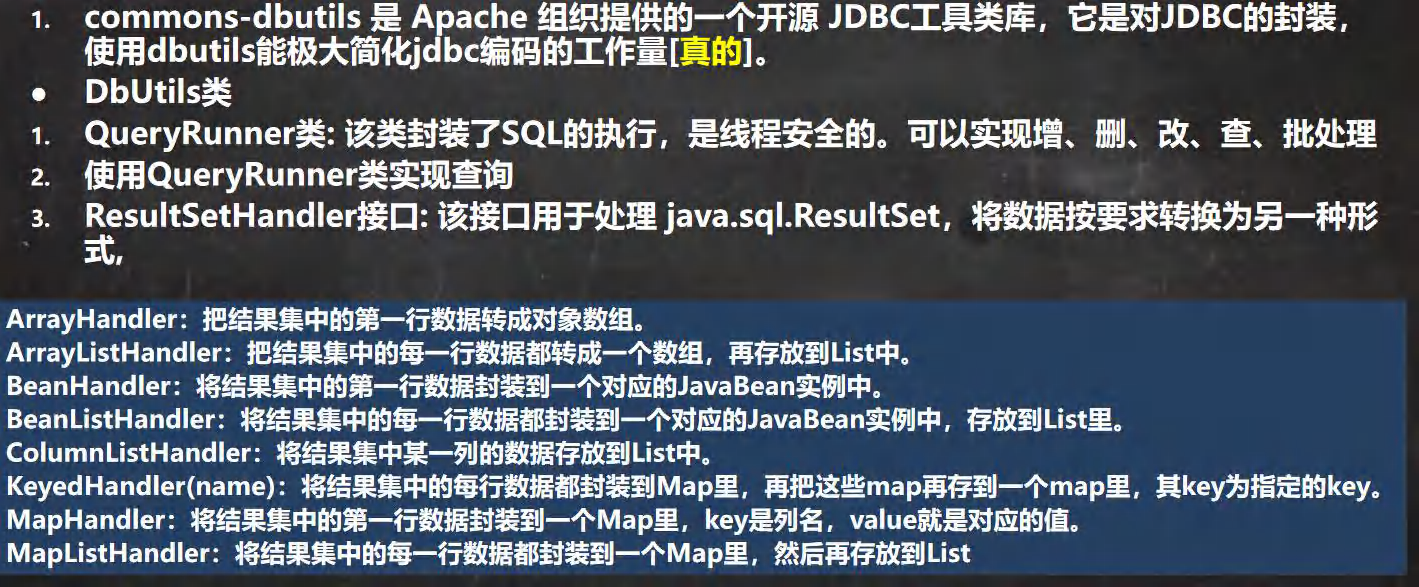
功能:隐式编译预处理sql语句–>执行SQL语句后,隐式处理CRUD结果(封装查询记录),直接返回存放记录的集合/对象–>隐式关闭结果集–>隐式关闭preparedstatement
提示:使用DBUtils同时使用德鲁伊工具类时,不需显示关闭结果集和preparedstatement
前置工作:
将commons-dbutils-1.3.jar拷贝到项目下指定的目录(libs)下,点击 add to project…加入到项目中
应用实例:
//使用 apache-DBUtils 工具类 + druid 完成对表的 crud 操作
public class DBUtils_USE {
@Test
//返回结果是多行的情况
public void selectManyTest() throws SQLException {
Connection connection = JDBCUtilsByDruid.getConnection();
//2. 使用 DBUtils 类和接口 , 先引入DBUtils 相关的jar , 加入到本Project
//3. 创建 QueryRunner
QueryRunner queryRunner = new QueryRunner();//org.apache.commons.dbutils
String sql = "select * from actor where id>?";
//(1) query 方法就是执行sql 语句,得到resultset ---封装到 --> ArrayList 集合中
//(2) 返回集合
//(3) connection: 连接
//(4) sql : 执行的sql语句
//(5) new BeanListHandler<>(Actor.class): 在将resultset -> Actor 对象 -> 封装到 ArrayList
// 底层使用反射机制 去获取Actor 类的属性,然后进行封装
//(6) 1 就是给 sql 语句中的? 赋值,可以有多个值,因为是可变参数Object... params
//(7) 底层得到的resultset ,会在query 关闭, 关闭PreparedStatment
/**
* 分析 queryRunner.query方法:
* public <T> T query(Connection conn, String sql, ResultSetHandler<T> rsh, Object... params) throws SQLException {
* PreparedStatement stmt = null;//定义PreparedStatement
* ResultSet rs = null;//接收返回的 ResultSet
* Object result = null;//返回ArrayList
*
* try {
* stmt = this.prepareStatement(conn, sql);//创建PreparedStatement
* this.fillStatement(stmt, params);//对sql 进行 ? 赋值
* rs = this.wrap(stmt.executeQuery());//执行sql,返回resultset
* result = rsh.handle(rs);//返回的resultset --> arrayList[result] [使用到反射,对传入class对象处理]
* } catch (SQLException var33) {
* this.rethrow(var33, sql, params);
* } finally {
* try {
* this.close(rs);//关闭resultset
* } finally {
* this.close((Statement)stmt);//关闭preparedstatement对象
* }
* }
*
* return result;
* }
*/
List<Actor> list = queryRunner.query(connection, sql, new BeanListHandler<>(Actor.class), 0);
System.out.println(list);
JDBCUtilsByDruid.close(null,null,connection);
}
@Test
//返回结果是单行的情况
public void selectSingle() throws SQLException {
Connection connection = JDBCUtilsByDruid.getConnection();
QueryRunner queryRunner = new QueryRunner();
String sql = "select * from actor where id=?";
// 因为我们返回的单行记录<--->单个对象 , 使用的Hander 是 BeanHandler
Actor actor = queryRunner.query(connection, sql, new BeanHandler<>(Actor.class), 3);
System.out.println(actor);
JDBCUtilsByDruid.close(null,null,connection);
}
@Test
//返回结果是标量(单行单列)的情况
public void selectsaclar() throws SQLException {
Connection connection = JDBCUtilsByDruid.getConnection();
QueryRunner queryRunner = new QueryRunner();
String sql = "select name from actor where id=?";
//返回单行单列 , 返回的就是Object,使用的handler 就是 ScalarHandler
Object o = queryRunner.query(connection, sql, new ScalarHandler(),3);
System.out.println(o);
JDBCUtilsByDruid.close(null,null,connection);
}
//演示 apache-dbutils + druid 完成 dml (update, insert ,delete)
@Test
public void dml() throws SQLException {
Connection connection = JDBCUtilsByDruid.getConnection();
String sql = "update actor set name=? where id=?";
sql = "insert into actor values(null,?,?,?,?)";
sql = "delete from actor where id=?";
QueryRunner queryRunner = new QueryRunner();
//(1) 执行dml 操作是 queryRunner.update()
//(2) 返回的值是受影响的行数 (affected: 受影响)
// queryRunner.update(connection, sql, "刘德华", 2);
// queryRunner.update(connection, sql, "黎明", "男","1971-11-11","114");
int affectedRow = queryRunner.update(connection, sql, 2);
System.out.println(affectedRow>0?"执行成功":"执行没有影响到表");
JDBCUtilsByDruid.close(null,null,connection);
}
}
补充:表和 JavaBean 的类型映射关系
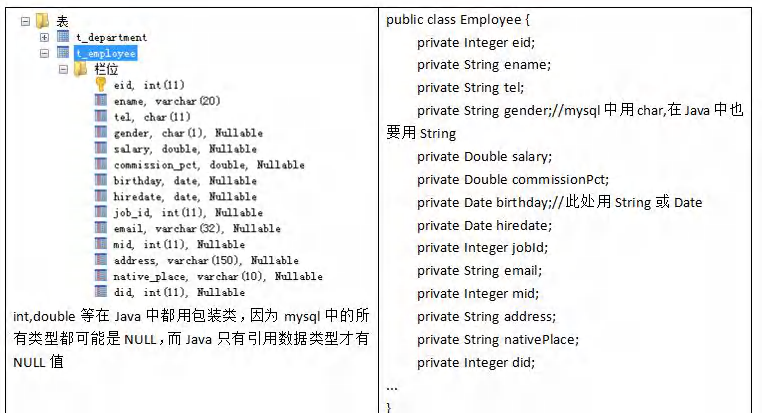
DAO
问题

说明
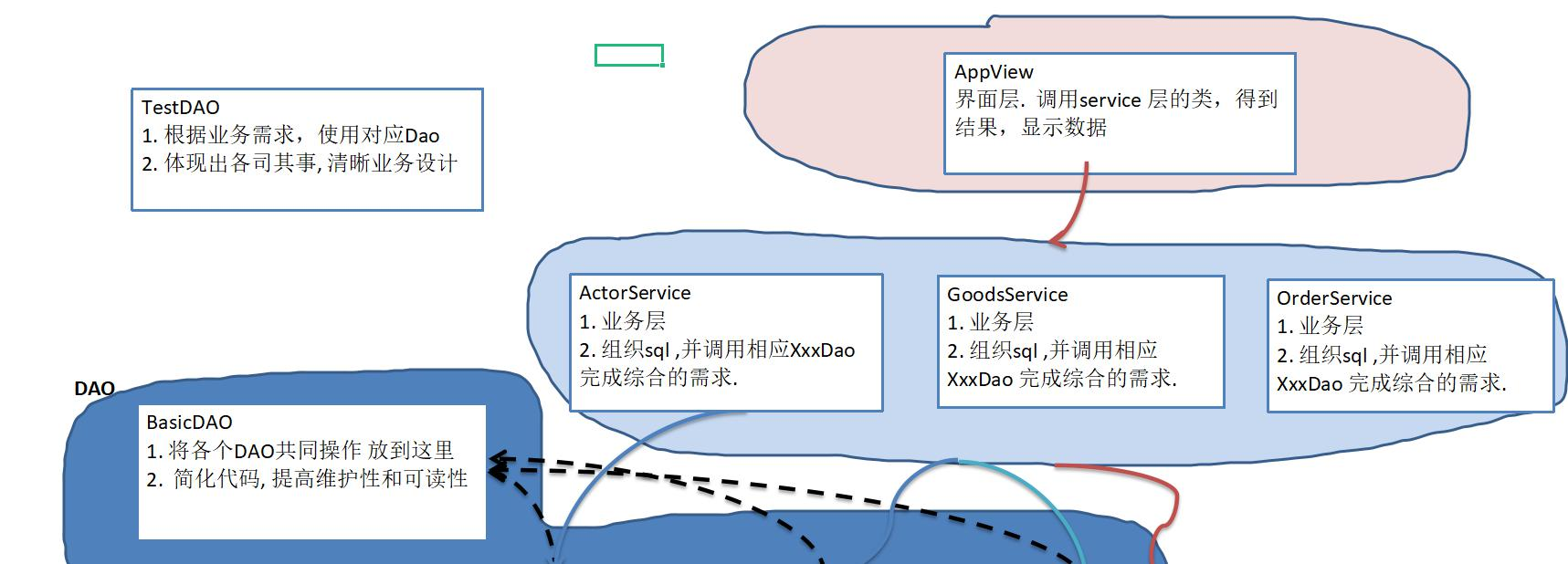
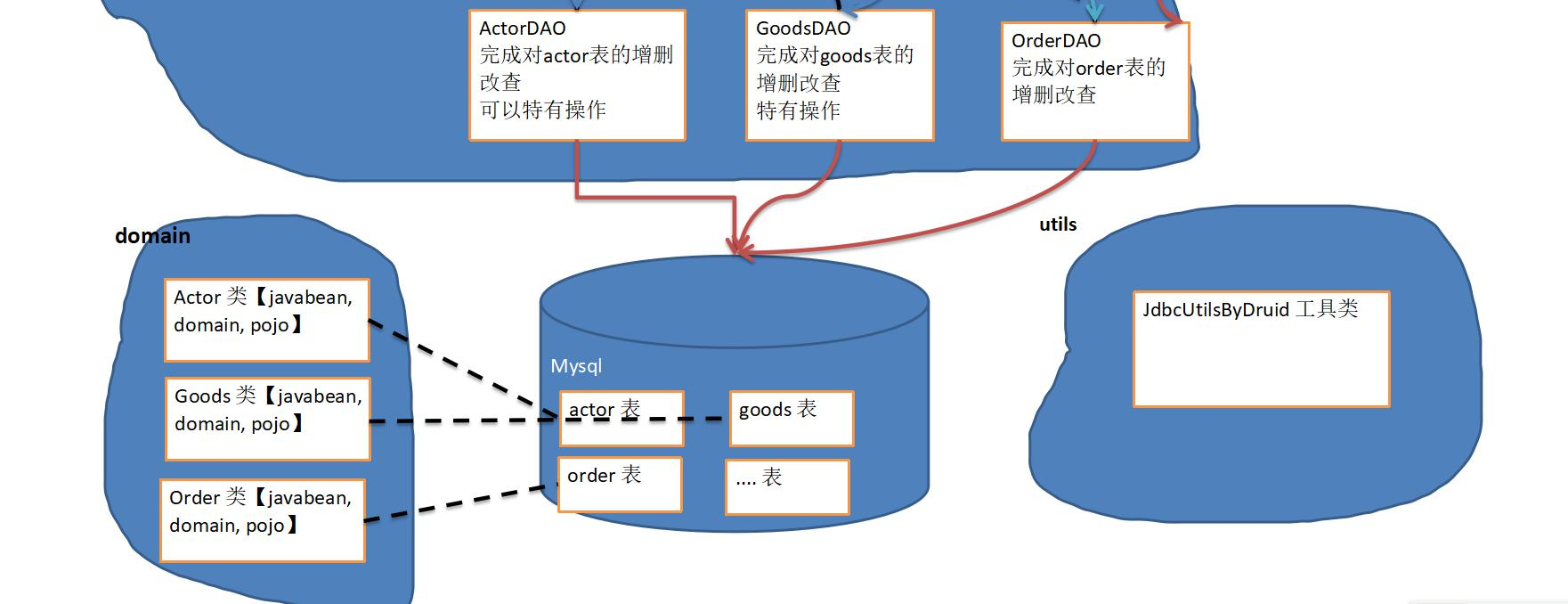

BasicDAO 应用实例

代码实现:
domain层:
package com.hspedu.dao_.domain;
import java.util.Date;
//javaBean/domain
public class Actor {
private Integer id;
private String name;
private String sex;
private Date borndate;
private String phone;
public Actor() {
}
public Actor(Integer id, String name, String sex, Date borndate, String phone) {
this.id = id;
this.name = name;
this.sex = sex;
this.borndate = borndate;
this.phone = phone;
}
public Integer getId() {
return id;
}
public void setId(Integer id) {
this.id = id;
}
public String getName() {
return name;
}
public void setName(String name) {
this.name = name;
}
public String getSex() {
return sex;
}
public void setSex(String sex) {
this.sex = sex;
}
public Date getBorndate() {
return borndate;
}
public void setBorndate(Date borndate) {
this.borndate = borndate;
}
public String getPhone() {
return phone;
}
public void setPhone(String phone) {
this.phone = phone;
}
@Override
public String toString() {
return "\nActor{" +
"id=" + id +
", name='" + name + '\'' +
", sex='" + sex + '\'' +
", borndate=" + borndate +
", phone='" + phone + '\'' +
'}';
}
}
utils层
package com.hspedu.dao_.utils;
import com.alibaba.druid.pool.DruidDataSourceFactory;
import javax.sql.DataSource;
import java.io.FileReader;
import java.sql.Connection;
import java.sql.ResultSet;
import java.sql.SQLException;
import java.sql.Statement;
import java.util.Properties;
/**
* @ClassName
* @Description
* @Author zxk
* @DateTime 2022-02-19-21:24
* @Version
*///基于druid数据库连接池的工具类
public class JDBCUtilsByDruid {
private static DataSource dataSource;
static {
Properties properties = new Properties();
try {
properties.load(new FileReader("src\\druid.properties"));
dataSource = DruidDataSourceFactory.createDataSource(properties);
} catch (Exception e) {
e.printStackTrace();
}
}
public static Connection getConnection() {
Connection connection=null;
try {
connection=dataSource.getConnection();
} catch (SQLException e) {
e.printStackTrace();
}
return connection;
}
public static void close(ResultSet resultSet, Statement statement, Connection connection) {
try {
if (resultSet != null) {
resultSet.close();
}
if (statement != null) {
statement.close();
}
if (connection != null) {
//Connection是接口,因第三方不同,Collection实现类不同
//这里关闭机制由原来的mysql里Collection实现类提供
//改为由Druid里的实现类提供关闭机制
//两者区别:后者把引用断掉,collection对象放回连接池
//前者:直接断开JDBC数据库连接
connection.close();
}
} catch (SQLException e) {
throw new RuntimeException(e);
}
}
}
dao层
package com.hspedu.dao_.dao;
import com.hspedu.dao_.utils.JDBCUtilsByDruid;
import org.apache.commons.dbutils.QueryRunner;
import org.apache.commons.dbutils.handlers.BeanHandler;
import org.apache.commons.dbutils.handlers.BeanListHandler;
import org.apache.commons.dbutils.handlers.ScalarHandler;
import java.sql.Connection;
import java.sql.SQLException;
import java.util.List;
//开发BasicDAO , 是其他DAO的父类
public class BasicDAO<T>{
private QueryRunner qr = new QueryRunner();//apache-DB工具类
private Connection connection ;
//开发通用的dml方法, 针对任意的表
public int update(String sql, Object... parameters) {
try {
connection = JDBCUtilsByDruid.getConnection();
return qr.update(connection, sql, parameters);
} catch (SQLException e) {
//将编译异常->运行异常 ,抛出,解决了:该方法接收不到返回语句的编译问题(作用域)
throw new RuntimeException(e);
} finally {
JDBCUtilsByDruid.close(null,null,connection);
}
}
//返回多个对象(即查询的结果是多行), 针对任意表
/**
*
* @param sql sql 语句,可以有 ?
* @param clazz clazz 传入一个类的Class对象 比如 Actor.class
* @param parameters parameters 传入 ? 的具体的值,可以是多个
* @return 根据Actor.class 返回对应的 ArrayList 集合
*/
public List<T> queryMulti(String sql, Class<T> clazz, Object... parameters) {
try {
connection = JDBCUtilsByDruid.getConnection();
return qr.query(connection, sql, new BeanListHandler<>(clazz), parameters);
} catch (Exception e) {
throw new RuntimeException(e);
} finally {
JDBCUtilsByDruid.close(null, null, connection);
}
}
//查询单行结果 的通用方法
public T querySingle(String sql, Class<T> clazz, Object... parameters) {
try {
connection = JDBCUtilsByDruid.getConnection();
return qr.query(connection,sql, new BeanHandler<>(clazz), parameters);
} catch (SQLException e) {
throw new RuntimeException(e);
} finally {
JDBCUtilsByDruid.close(null,null,connection);
}
}
//查询单行单列的方法,即返回单值的方法
public Object queryScalar(String sql, Object... parameters) {
try {
connection = JDBCUtilsByDruid.getConnection();
return qr.query(connection, sql, new ScalarHandler(), parameters);
} catch (Exception e) {
throw new RuntimeException(e);
} finally {
JDBCUtilsByDruid.close(null,null,connection);
}
}
}
package com.hspedu.dao_.dao;
import com.hspedu.dao_.domain.Actor;
public class ActorDAO extends BasicDAO<Actor> {
//1. 就有 BasicDAO 的方法
//2. 根据业务需求,可以编写特有的方法.
}
view层(测试)
package com.hspedu.dao_.test;
import com.hspedu.dao_.dao.ActorDAO;
import com.hspedu.dao_.domain.Actor;
import org.junit.jupiter.api.Test;
import java.util.List;
public class TestDAO {
@Test
public void testActorDAO() {
ActorDAO actorDAO = new ActorDAO();
//4. dml操作 insert ,update, delete
int update = actorDAO.update("update actor set name='周星驰' where id=?", 3);
System.out.println(update>0?"执行成功":"没有受影响的行数");
//1. 查询多行记录
List<Actor> actors = actorDAO.queryMulti("select * from actor where id>?", Actor.class, 0);
for (Actor actor : actors) {
System.out.println(actor);
}
//2. 查询单行记录
Actor actor = actorDAO.querySingle("select * from actor where id=?", Actor.class, 4);
System.out.println(actor);
//3. 查询单行单列
Object o = actorDAO.queryScalar("select * from actor where id=?", 4);
System.out.println(o);
}
}





 本文详细介绍了JDBC接口及其使用,包括JDBC的基本概念、JDBC API的关键部分、连接管理、预处理语句、事务、批处理、数据库连接池和常见工具如C3P0和Druid的应用。还涵盖了如何避免SQL注入和提高性能的最佳实践。
本文详细介绍了JDBC接口及其使用,包括JDBC的基本概念、JDBC API的关键部分、连接管理、预处理语句、事务、批处理、数据库连接池和常见工具如C3P0和Druid的应用。还涵盖了如何避免SQL注入和提高性能的最佳实践。
















 3426
3426


 被折叠的 条评论
为什么被折叠?
被折叠的 条评论
为什么被折叠?







